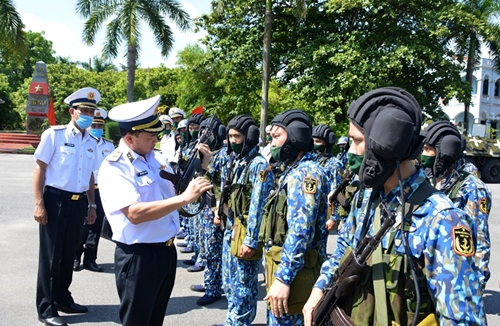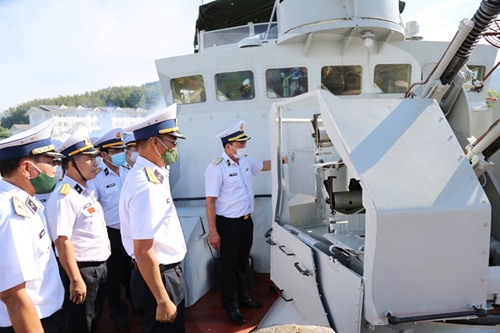The legendary trail was operated by the efforts, wisdom, and blood of compatriots and soldiers across the country, in which the Naval Service is honored to be the core force.
Sixty years ago, on October 23, 1961, the Ministry of National Defense established Unit 759 (also called as the no-number ship unit), the predecessor of Unit 125 (now Brigade 125 of Naval Region 2). The unit was tasked with opening a strategic transport route in the East Sea (South China Sea) named after President Ho Chi Minh, providing human and material resources for the Southern theater to fight against the U.S. imperialists and Saigon puppet government.
    |
 |
|
Leaders of the Naval Service inspect the combat readiness status of a unit. |
Under the leadership of the Central Military Commission, the Ministry of National Defense, and the Naval Service Command, the unit’s troops overcame all hardships and transported hundreds of tons of weapons and thousands of servicemen to the Southern theater, creating the legendary Ho Chi Minh Trail at Sea.
Their feats-of-arms were sourced from the sound leadership of the Party Central Committee, the Central Military Commission, and the Ministry of National Defense, as well as the combined strength of the whole Vietnamese people and the solidarity of the people and troops in Northern and Southern regions.
First of all, as the main combat force in the sea direction, the Naval Service was trusted by the Ministry of National Defense, and assigned the task of organizing sea transportation to support the Southern theater. Nine years since its establishment, the force had increasingly developed in all aspects, from a research agency to a naval service of the Vietnam People’s Army, directly undertaking the task of protecting the national sovereignty over seas and islands.
The service had increasingly developed in term of structure, forces, and vehicles, in order to undertake two important missions at the same time, particularly protecting the Northern region and supporting the struggle of the Southern people.
Secondly, the Naval Service suggested the Ministry of National Defense to launch voyages with appropriate vehicles to assist the Southern theater.
Since the establishment of Unit 759, the Naval Service conducted numerous surveys and experiments to find appropriate routes for transportation, contributing to the launch of the Ho Chi Minh Trail at Sea in October 1962.
After receiving Unit 759 (in September 1963) and renaming it to Unit 125 (January 1964), the Naval Service directly commanded and led the ships on five different routes, including two onshore routes and 3 offshore routes. The nearest route was about 1,000 nautical miles long, the farthest was up to 3,500 nautical miles long.
When the no-number ships were detected by the enemy, the naval service ordered the ships to move to international waters, and directed them to define main and backup routes to cope with the enemy and bring supplies to the destinations safely.
The Naval Service Command also proactively proposed to the defense leaderships to use appropriate transport vehicles in each situation, such as motorized wooden ships or iron-hulled ones.
Also, the service directed Unit 125 to flexibly apply transport methods, combining covert and overt modes, using fake-numbered ships at the same time departing from many berths, approaching the unloading docks in many directions in order to avoid the enemy’s detection.
Thirdly, the service’s Party Committee and Chain-of-Command directly commanded and operated Unit 759 since September 1963 following the assignment of the Ministry of National Defense.
Troops of the group promoted courage, creativeness, and determination to fulfill their assigned tasks, contributing to assisting the Southern people in the combat against foreign invaders. In addition, they were regularly trained and updated with knowledge to meet their task requirements.
The close coordination between the Naval Service and relevant forces contributed to ensuring the smooth operation of the Ho Chi Minh Trail at Sea and limiting sacrifices and losses.
    |
 |
|
Leaders of the Naval Service inspect Ship 332 of Brigade 172 of Naval Region 3. |
Fourthly, many forces participated in the transportation of the Ho Chi Minh Trail at Sea in numerous stages. Unit 125 was the key force, in charge of the hardest tasks. It operated nearly 2,000 voyages carrying over 100,000 tons of supplies and dozens of thousands of servicemen.
Hundreds of naval troops of Group 125 died, were wounded, or seized by the enemy while dozens of ships were destroyed.
The Ho Chi Minh Trail at Sea and the heroic traditions of the no-number ships will forever be the pride of the Vietnam People’s Army and Vietnamese people in general, and generations of naval troops in particular.
Today, the historical values and lessons learned from the Ho Chi Minh Trail at Sea are still being preserved, promoted and creatively applied to the cause of building a revolutionary, regular, elite, and gradually-modernized navy as the core force to firmly protect the country's maritime sovereignty in the new situation.
Translated by Trung Thanh